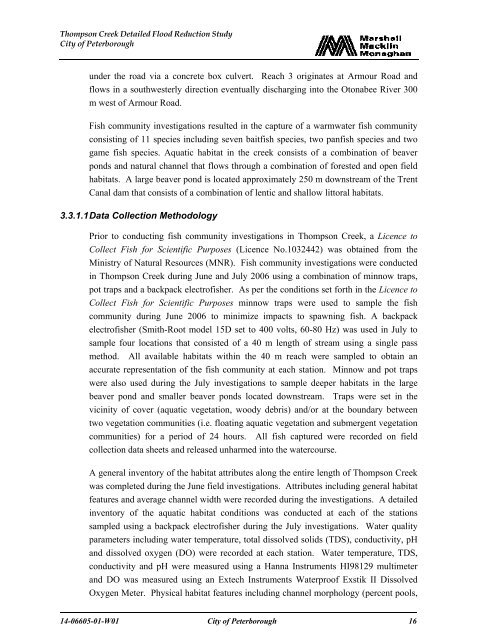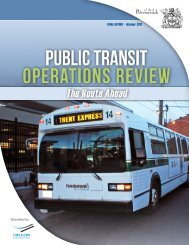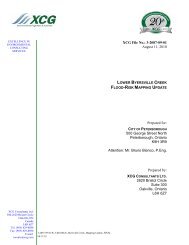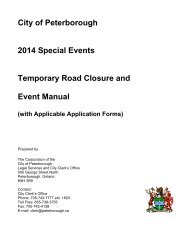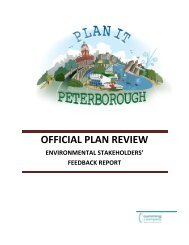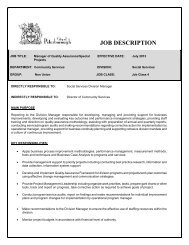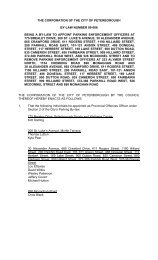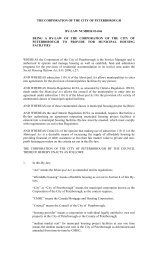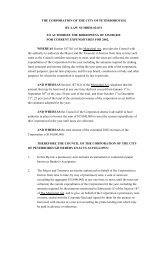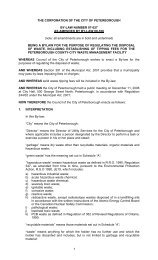Thompson Creek Flood Study Report - City of Peterborough
Thompson Creek Flood Study Report - City of Peterborough
Thompson Creek Flood Study Report - City of Peterborough
You also want an ePaper? Increase the reach of your titles
YUMPU automatically turns print PDFs into web optimized ePapers that Google loves.
<strong>Thompson</strong> <strong>Creek</strong> Detailed <strong>Flood</strong> Reduction <strong>Study</strong><br />
<strong>City</strong> <strong>of</strong> <strong>Peterborough</strong><br />
under the road via a concrete box culvert. Reach 3 originates at Armour Road and<br />
flows in a southwesterly direction eventually discharging into the Otonabee River 300<br />
m west <strong>of</strong> Armour Road.<br />
Fish community investigations resulted in the capture <strong>of</strong> a warmwater fish community<br />
consisting <strong>of</strong> 11 species including seven baitfish species, two panfish species and two<br />
game fish species. Aquatic habitat in the creek consists <strong>of</strong> a combination <strong>of</strong> beaver<br />
ponds and natural channel that flows through a combination <strong>of</strong> forested and open field<br />
habitats. A large beaver pond is located approximately 250 m downstream <strong>of</strong> the Trent<br />
Canal dam that consists <strong>of</strong> a combination <strong>of</strong> lentic and shallow littoral habitats.<br />
3.3.1.1 Data Collection Methodology<br />
Prior to conducting fish community investigations in <strong>Thompson</strong> <strong>Creek</strong>, a Licence to<br />
Collect Fish for Scientific Purposes (Licence No.1032442) was obtained from the<br />
Ministry <strong>of</strong> Natural Resources (MNR). Fish community investigations were conducted<br />
in <strong>Thompson</strong> <strong>Creek</strong> during June and July 2006 using a combination <strong>of</strong> minnow traps,<br />
pot traps and a backpack electr<strong>of</strong>isher. As per the conditions set forth in the Licence to<br />
Collect Fish for Scientific Purposes minnow traps were used to sample the fish<br />
community during June 2006 to minimize impacts to spawning fish. A backpack<br />
electr<strong>of</strong>isher (Smith-Root model 15D set to 400 volts, 60-80 Hz) was used in July to<br />
sample four locations that consisted <strong>of</strong> a 40 m length <strong>of</strong> stream using a single pass<br />
method. All available habitats within the 40 m reach were sampled to obtain an<br />
accurate representation <strong>of</strong> the fish community at each station. Minnow and pot traps<br />
were also used during the July investigations to sample deeper habitats in the large<br />
beaver pond and smaller beaver ponds located downstream. Traps were set in the<br />
vicinity <strong>of</strong> cover (aquatic vegetation, woody debris) and/or at the boundary between<br />
two vegetation communities (i.e. floating aquatic vegetation and submergent vegetation<br />
communities) for a period <strong>of</strong> 24 hours. All fish captured were recorded on field<br />
collection data sheets and released unharmed into the watercourse.<br />
A general inventory <strong>of</strong> the habitat attributes along the entire length <strong>of</strong> <strong>Thompson</strong> <strong>Creek</strong><br />
was completed during the June field investigations. Attributes including general habitat<br />
features and average channel width were recorded during the investigations. A detailed<br />
inventory <strong>of</strong> the aquatic habitat conditions was conducted at each <strong>of</strong> the stations<br />
sampled using a backpack electr<strong>of</strong>isher during the July investigations. Water quality<br />
parameters including water temperature, total dissolved solids (TDS), conductivity, pH<br />
and dissolved oxygen (DO) were recorded at each station. Water temperature, TDS,<br />
conductivity and pH were measured using a Hanna Instruments HI98129 multimeter<br />
and DO was measured using an Extech Instruments Waterpro<strong>of</strong> Exstik II Dissolved<br />
Oxygen Meter. Physical habitat features including channel morphology (percent pools,<br />
14-06605-01-W01 <strong>City</strong> <strong>of</strong> <strong>Peterborough</strong> 16


